Auction Highlights | Fine Clocks, Barometers and Scientific Instruments | 27 February 2024
On Tuesday 27 February, we have our first Fine Clocks, Barometers and Scientific Instruments auction of the year. Offering nearly two hundred lots, this carefully curated auction features an extensive selection of fine and rare pieces for the avid horologist. Here, we take a look at some of the highlights.
A fine and rare Charles I brass 'First Period' lantern clock attributed to the workshop of William Bowyer
A particular highlight is Lot 163, a fine and rare Charles I brass 'First Period' lantern clock. Dating to circa 1630, it is attributed to the workshop of William Bowyer. The dial is signed for Claudius Malbranck of London, indicating that he was most likely the original owner. Of larger proportions, it utilises the lantern clock design, styled after a typical lantern shape of the period, which was popular from the early 1600s through to the late 18th century.
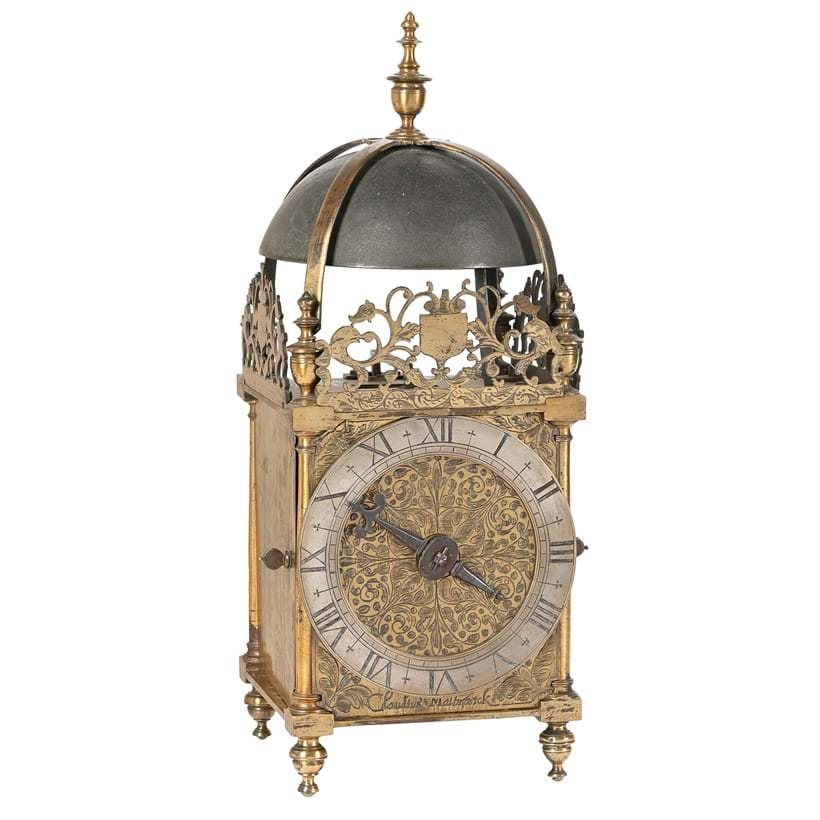
Perhaps the most obvious single piece of evidence to support attribution to Bowyer is the design of the frets used. Although they appear to be outwardly similar to those used on other, smaller clocks, they are almost unique with the only other known example to have matching castings being a clock made by Bowyer in 1632 for the Brewers' Company. In addition to the frets used, the dial engraving of the Brewers' clock also exhibits notable similarities with that of the current lot with foliate designs executed in quartered segments. Another clock by Bowyer, this time made for the Earl of Rothes, also has very closely related engraving by the same hand.
The movement also has many features typical of Bowyer's work, most notably the 'hump' cast into the rear movement bar left hand arm to allow for the locking detent arbor pivots, finely executed wheelwork with tapered arbors, decorative blade hammer spring opposing a very substantial stop and iron countwheel. The frame utilises the same casting as the Earl of Rothes clock and is very finely finished with precise turnings and canted filed edges to the bell support straps.
The present clock is particularly notable in that it has survived in fine, original untouched condition. At some point the original verge escapement and balance has been substituted for an anchor escapement regulated by a seconds pendulum and the winding converted to Huygens's design with an endless chain. Most importantly the latter has not resulted in the strike train being reversed, this has been achieved by adding a very discreet small intermediate wheel to the going train front movement bar, between the pinion of report and the hour wheel. Otherwise the clock is very much the same as when it would have left the Leadenhall Street workshop of William Bowyer but with light wear and the build-up of patination resulting in very pleasing mellow colouring that can only come with age.
A fine Victorian gilt brass giant carriage clock by John Carter
Dating to circa 1860, Lot 107 is a fine Victorian gilt brass giant carriage clock with push-button repeat made by John Carter of London.
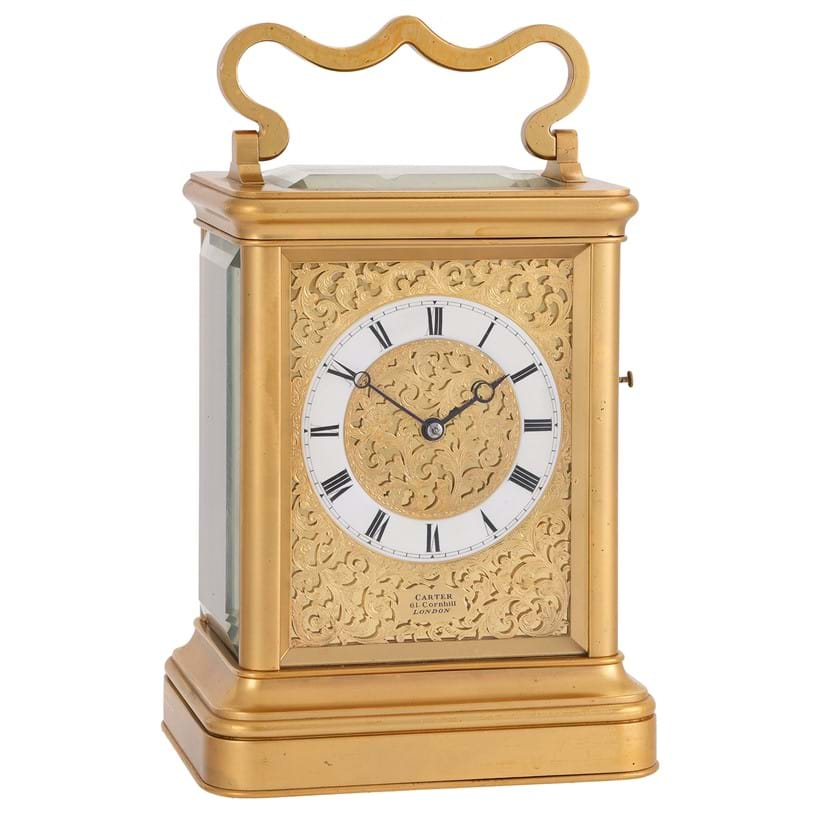
John Carter was as born in 1803. He apprenticed to Boys Err Burrill, gaining his Freedom of the Clockmakers' Company in 1829. He is listed in directories as working from Tooley Street, London as a watch and chronometer maker with additional premises at 61 Cornhill from 1840. He submitted many chronometers for the trials at Greenwich coming first in 1834 with chronometer number 144, and again the following year with watch number 160. He also became involved with the City of London becoming an Alderman in 1851 and serving as Lord Mayor in 1859. He also served three times as Master of the Clockmakers' Company in 1856, 1859 and 1864. In 1873 John Carter took his son, John William, into partnership who then continued the business after John Carter's death in May 1878.
A Fine William and Mary Ebony Table Clock by Samuel Watson
Next, Lot 190 is a fine William and Mary ebony table clock by important clockmaker and mathematician, Samuel Watson. This interesting piece is not strictly a clock but a timepiece insomuch that it does not strike the hours through normal operation. Technically speaking a ‘clock’ should incorporate a striking mechanism with the origins of the word itself referring to the bell of a timepiece (think ‘cloche’ in French or ‘glocke’ in German) rather than the timekeeping aspect of the mechanism. Although this timepiece does not automatically announce its presence on the hour it does, however, incorporate a mechanism which sounds the hour and last half hour on demand only - by pulling on a cord that exits the case. This unusual system is termed ‘silent pull quarter-repeat’ which, to horologists, indicates that the clock is indeed silent unless asked.
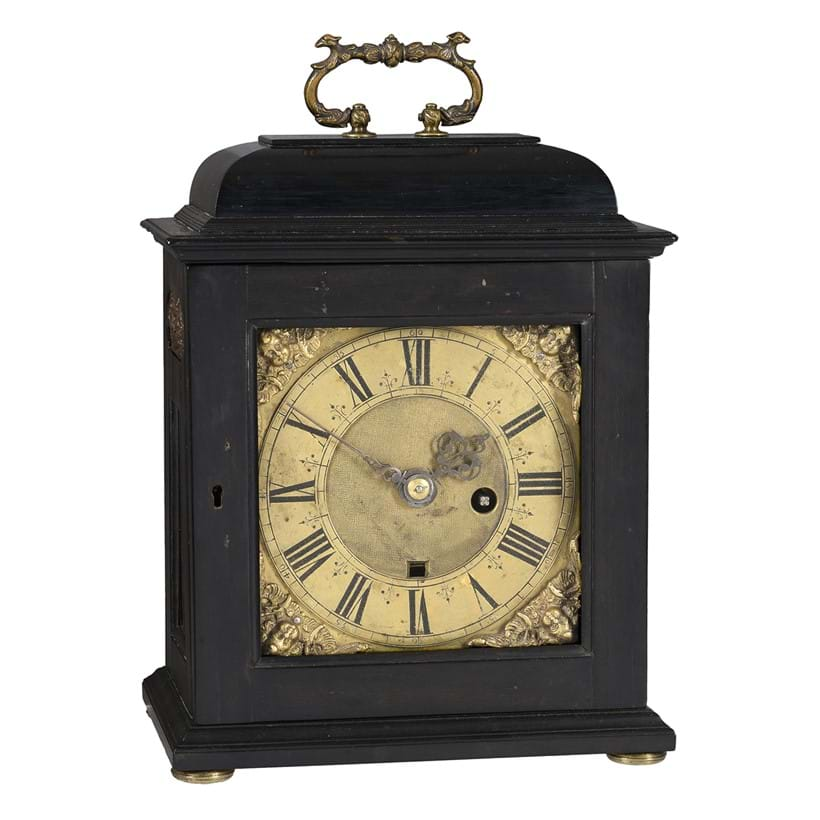
Timepieces of this specification were made with the bedchamber in mind, allowing the owner to ascertain the time in the dark. In the 17th century, at the time when this timepiece was made (circa 1690) clocks were very expensive luxury items that could only be afforded by the wealthiest of individuals. In most cases even very affluent households could afford to possibly have two or three clocks; a longcase ‘house’ clock for the entrance hall; a weight-driven short duration alarm timepiece (a lantern or hook-and-spike clock) to wake the servants; and a spring clock for the drawing room which would also be taken upstairs to the bedchamber at night. As a consequence silent-pull quarter repeating timepieces are rarer as the original owner would have to be very wealthy indeed to afford a timepiece reserved exclusively for use in the bed chamber.
Samuel Watson was recorded as initially working in Coventry from around 1680 where he was Sheriff in 1686, before moving to Long Acre, London, in around 1691. He was admitted to the Clockmakers' Company as a free Brother in 1692. He was supposedly 'Mathematician ordinary' to Charles II for whom he made an astronomical clock in 1682 followed by another clock which he did not finish until after the King's death. This clock was eventually sold to Queen Mary on its completion in 1690 and is preserved at Windsor Castle albeit in a later case. He also made two further complex astronomical clocks for Isaac Newton and invented five minute repeating for watches. He worked with the Lichfield based physician, John Floyer, in developing a medical 'pulse watch' which was subsequently advertised in 1707. Latterly, in November 1712, Watson approached the Clockmaker's Company with an instrument to 'discover the houre of the day at sea and several other useful mathematical matters' but to no avail.
A fine George II gilt brass mounted walnut table/bracket clock by William Webster
Another highlight is Lot 187, a fine George II gilt brass mounted walnut table/bracket clock, dating to circa 1730, by William Webster of London. The clock features a pull-quarter repeat on six bells, to a design also used in clocks by Daniel Delander, Simon DeCharmes, John Purden and John Pyke. The case of the current lot is particularly notable both in the selection of the fine figured walnut veneers and the quality of the engraved gilt brass frets which are amongst the finest seen on clocks from this period.
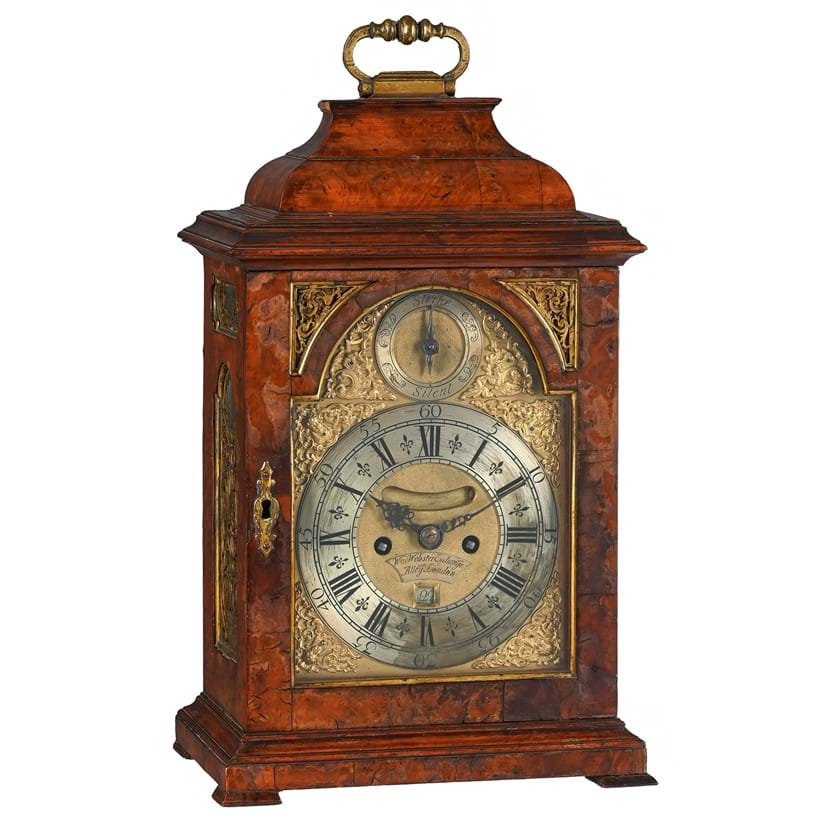
William Webster Senior was apprenticed to Thomas Tompion, gaining his Freedom from The Clockmakers' Company in 1710. He initially worked as a journeyman to Tompion, later setting up business in Exchange Alley, London in 1711. Four days after Tompion's death on 20 November 1713 Webster placed a newspaper advertisement stating that he had worked for Tompion and was now working on his own at the Dial and Three Crowns in Exchange Alley. William Webster was elected to the position of Junior Warden in the Clockmakers Company in 1734 but died during his year in office on 13 August 1735. William Webster Junior was apprenticed to his father in 1727 gaining his Freedom in 1734, he was appointed Master of the Clockmakers' Company in 1755. He was a fine maker who very much maintained his father's standards in his work.
A rare George III brass 6 inch Gregorian reflecting telescope by W. and S. Jones
Finally, from the selection of scientific instruments, Lot 5 is a rare George III brass 6 inch Gregorian reflecting telescope, by W. and S. Jones of London. The Gregorian telescope is named after the Scottish mathematician and astronomer, James Gregory (1638-75), who first published his design for a reflecting telescope in his 1663 work Optica Promota. Technical limitations with regards to the productions of the mirrors required meant that Gregory was not able to construct his design until the mid 1670's in collaboration with Robert Hooke. The current lot is a scarce, larger model, as most examples produced during the latter part of the 18th century tended to be less than four inches in diameter.
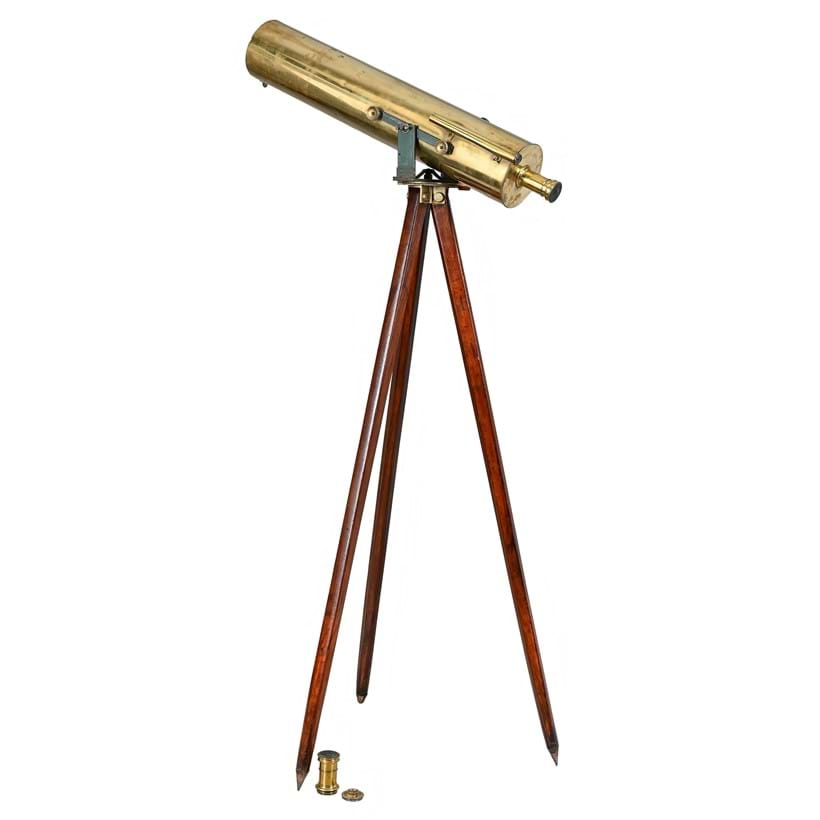
William and Samuel Jones were optical, mathematical and philosophical instrument makers who worked from several addresses in Holborn from 1791-1859. William Jones was apprenticed to the highly regarded maker Benjamin Martin, whilst Samuel was apprenticed to George Adams (junior) instrument-maker to George III and optician to the Prince of Wales. The partnership was one of the most important firms of scientific instrument makers of the late Georgian/Regency period and were particularly well known for their microscopes.
View page turning catalogue
Auction Details
Tuesday 27 February, 10.30am GMT
Donnington Priory, Newbury, Berkshire RG14 2JE
Browse the catalogue
Sign up to email alerts
VIEWING:
- Viewing in Newbury:
- Friday 23 February: 10am-4pm
- Sunday 25 February: 10am-3pm
- Monday 26 February: 10am-4pm
- Tuesday 27 February: from 8.30am

















